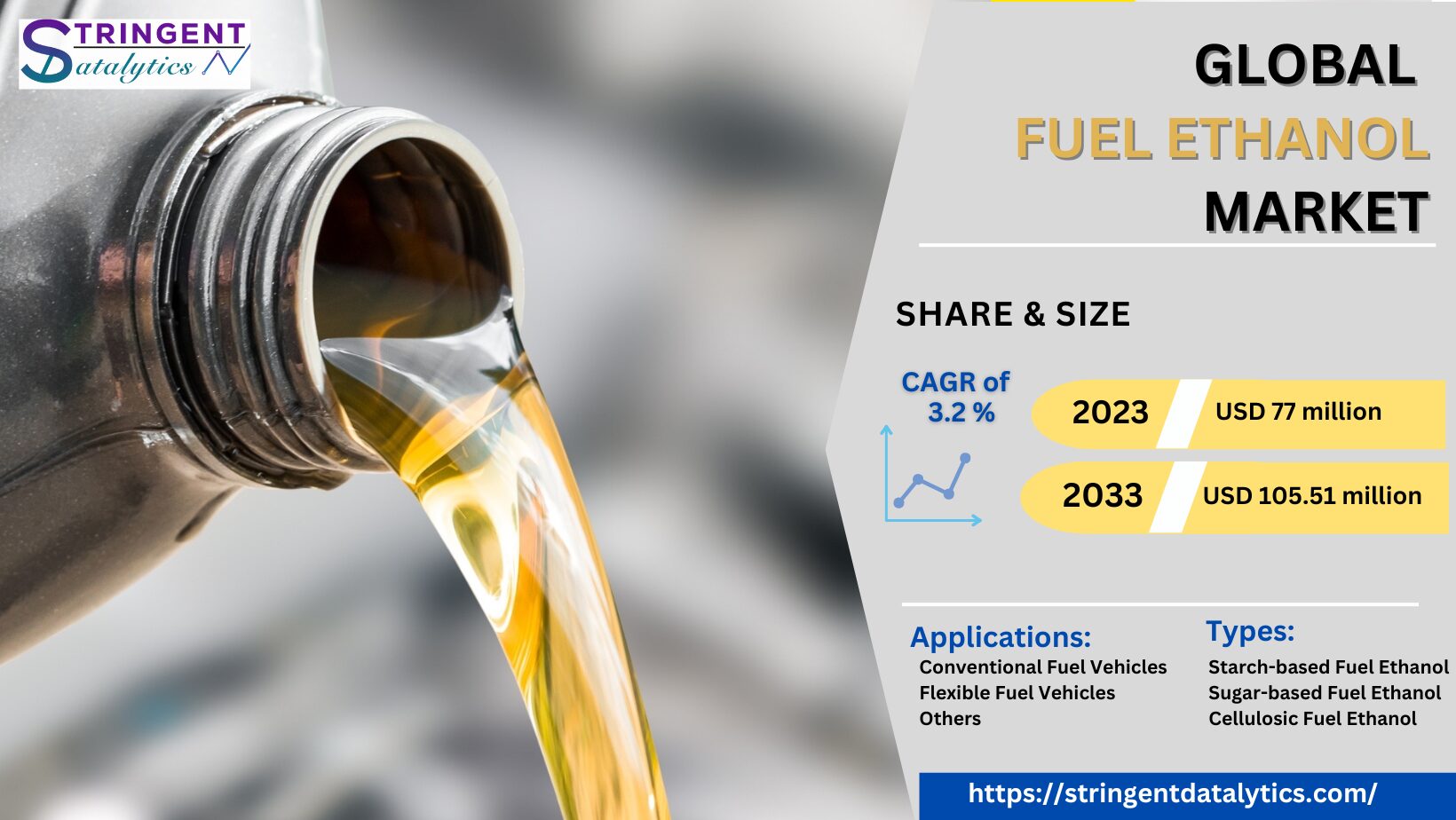The global Fuel Ethanol market was valued at USD 77 million in 2023 and is anticipated to reach USD 105.51 million by 2033, witnessing a CAGR of 3.2% during the forecast period 2024-2033.
Introduction
The fuel ethanol market has emerged as a crucial component of the global renewable energy landscape. As the world grapples with the pressing need to reduce greenhouse gas emissions and mitigate climate change, biofuels like ethanol have gained significant traction. This article delves into various facets of the fuel ethanol market, including its current trends, growth drivers, challenges, and future opportunities. By examining these aspects, we aim to provide a comprehensive understanding of this dynamic and rapidly evolving sector.
Market Overview
Fuel Ethanol Market Trends
The fuel ethanol market is characterized by several notable trends. One of the most significant is the increasing adoption of ethanol-blended fuels. Many countries have mandated the blending of ethanol with gasoline to reduce carbon emissions and reliance on fossil fuels. This regulatory push has significantly bolstered the demand for fuel ethanol. Additionally, advancements in ethanol production technologies are driving efficiency and cost-effectiveness, further propelling market growth.
Global Fuel Ethanol Industry
The global fuel ethanol industry is marked by diverse regional dynamics. North America, particularly the United States, is the largest producer and consumer of ethanol, driven by supportive government policies and a well-established agricultural sector. Brazil follows closely, leveraging its vast sugarcane plantations for ethanol production. Europe and Asia-Pacific are also significant markets, with increasing adoption of biofuels to meet environmental targets and reduce oil dependence.
Fuel Ethanol Market Size
As of 2024, the global fuel ethanol market is valued at approximately USD 85 billion. The market has witnessed steady growth over the past decade, driven by rising environmental awareness and supportive government policies. Projections indicate that the market will continue to expand, reaching an estimated USD 120 billion by 2030, with a compound annual growth rate (CAGR) of around 5.5%.
Fuel Ethanol Market Forecast
The future of the fuel ethanol market looks promising, with several factors contributing to its positive outlook. The increasing global emphasis on renewable energy sources, coupled with technological advancements in ethanol production, is expected to drive sustained growth. Moreover, expanding applications of ethanol in sectors such as aviation and marine fuel present new opportunities for market expansion.
Fuel Ethanol Market Growth
The growth trajectory of the fuel ethanol market is underpinned by several key factors. Government mandates and subsidies for biofuels play a crucial role in driving demand. Additionally, rising crude oil prices make ethanol a more economically viable alternative. Innovations in feedstock utilization, such as the use of non-food crops and agricultural waste, are also contributing to market growth by ensuring a sustainable supply of raw materials.
Regional Fuel Ethanol Markets
Regional variations in the fuel ethanol market are pronounced. In North America, the United States leads with significant production capacity and consumption driven by the Renewable Fuel Standard (RFS). Brazil’s market is primarily fueled by its sugarcane ethanol industry, supported by the Proálcool program. In Europe, countries like Germany and France are key players, while in Asia-Pacific, China and India are rapidly scaling up their ethanol production capacities.
Fuel Ethanol Market Dynamics
Understanding the dynamics of the fuel ethanol market requires examining both demand and supply factors. On the demand side, environmental regulations and the push for cleaner fuels are major drivers. On the supply side, factors such as feedstock availability, production costs, and technological advancements play critical roles. Additionally, market dynamics are influenced by geopolitical factors, trade policies, and fluctuations in crude oil prices.
Market Drivers
Fuel Ethanol Demand Drivers
The demand for fuel ethanol is driven by multiple factors. Environmental concerns and the need to reduce greenhouse gas emissions are primary drivers, as ethanol is considered a cleaner alternative to fossil fuels. Government policies and mandates, such as the Renewable Fuel Standard in the US and the Renewable Energy Directive in the EU, are also significant drivers. Additionally, the rising cost of crude oil and the need for energy security are prompting countries to adopt ethanol as a viable fuel option.
Renewable Energy Policies
Renewable energy policies play a crucial role in shaping the fuel ethanol market. Governments worldwide are implementing policies to promote the use of renewable energy sources, including biofuels. These policies often include blending mandates, tax incentives, and subsidies to encourage ethanol production and consumption. The success of such policies in driving market growth depends on their design, implementation, and enforcement.
Environmental Regulations
Stringent environmental regulations are compelling industries to adopt cleaner and more sustainable practices. The fuel ethanol market benefits from these regulations, as ethanol is a renewable fuel that can help reduce carbon emissions. Regulations such as the Low Carbon Fuel Standard (LCFS) in California and the European Union’s Renewable Energy Directive (RED) are promoting the use of ethanol-blended fuels, thereby driving demand.
Biofuel Incentives
Governments and organizations are offering various incentives to promote the production and use of biofuels, including ethanol. These incentives can take the form of tax credits, grants, and subsidies for biofuel producers and users. By lowering production costs and making ethanol more competitive with fossil fuels, these incentives are crucial in driving market growth. The effectiveness of biofuel incentives depends on their alignment with market needs and sustainability goals.
Technological Innovations
Technological innovations are transforming the fuel ethanol industry. Advances in fermentation technologies, enzyme development, and process optimization are enhancing production efficiency and reducing costs. The development of second-generation biofuels, which use non-food biomass, is a significant technological breakthrough that promises higher yields and greater sustainability. Continued innovation is essential to address challenges and capitalize on emerging opportunities in the ethanol market.
Market Opportunities in Biofuels
The biofuels sector, including fuel ethanol, presents numerous market opportunities. Growing environmental awareness and the push for renewable energy are creating demand for cleaner fuels. Emerging markets in Asia-Pacific, Latin America, and Africa offer significant growth potential due to increasing energy needs and favorable government policies. Additionally, the expanding applications of ethanol in sectors such as aviation, marine fuel, and industrial chemicals are opening new avenues for market expansion.
Consumer Preferences for Biofuels
Consumer preferences are increasingly shifting towards sustainable and environmentally friendly products. This shift is driving the demand for biofuels, including ethanol, as consumers seek alternatives to fossil fuels. Educating consumers about the benefits of ethanol-blended fuels and promoting their use through marketing and awareness campaigns can further boost demand. Understanding and catering to consumer preferences is crucial for the sustained growth of the fuel ethanol market.
Receive the FREE Sample Report of Fuel Ethanol Market Research Insights @ https://stringentdatalytics.com/sample-request/fuel-ethanol-market/14979/
Market Segmentations:
Global Fuel Ethanol Market: By Company
Archer Daniels Midland Company
BlueFire Renewables
BP
Cargill
DowDuPont
Flint Hills Resources
Green Plains Renewable
Jilin Fuel Ethanol
Pacific Ethanol
Valero Energy Corporation
Raízen
Wilmar International
Global Fuel Ethanol Market: By Type
Starch-based Fuel Ethanol
Sugar-based Fuel Ethanol
Cellulosic Fuel Ethanol
Global Fuel Ethanol Market: By Application
Conventional Fuel Vehicles
Flexible Fuel Vehicles
Others
Regional Analysis of Global Fuel Ethanol Market
All the regional segmentation has been studied based on recent and future trends, and the market is forecasted throughout the prediction period. The countries covered in the regional analysis of the Global Fuel Ethanol market report are U.S., Canada, and Mexico in North America, Germany, France, U.K., Russia, Italy, Spain, Turkey, Netherlands, Switzerland, Belgium, and Rest of Europe in Europe, Singapore, Malaysia, Australia, Thailand, Indonesia, Philippines, China, Japan, India, South Korea, Rest of Asia-Pacific (APAC) in the Asia-Pacific (APAC), Saudi Arabia, U.A.E, South Africa, Egypt, Israel, Rest of Middle East and Africa (MEA) as a part of Middle East and Africa (MEA), and Argentina, Brazil, and Rest of South America as part of South America.
Click to Purchase Fuel Ethanol Market Research Report @ https://stringentdatalytics.com/purchase/fuel-ethanol-market/14979/?license=single
Production and Supply
Fuel Ethanol Production Process
The production of fuel ethanol involves several steps, primarily through fermentation of sugars derived from crops such as corn, sugarcane, and sorghum. The process begins with the milling of these feedstocks to extract fermentable sugars. These sugars are then fermented using yeast, converting them into ethanol and carbon dioxide. The resulting ethanol is distilled and dehydrated to achieve the desired purity levels for fuel use. Advances in cellulosic ethanol production, which uses non-food biomass, are also gaining traction, promising higher yields and lower environmental impact.
Fuel Ethanol Supply Chain
The fuel ethanol supply chain encompasses various stages, from feedstock cultivation and harvesting to ethanol production, distribution, and end-use. Efficient supply chain management is crucial to ensure a consistent and cost-effective supply of ethanol. Challenges such as feedstock variability, transportation logistics, and storage stability must be addressed to optimize the supply chain. Innovations such as blockchain technology are being explored to enhance traceability and efficiency across the supply chain.
Fuel Ethanol Production Costs
Production costs for fuel ethanol are influenced by several factors, including feedstock prices, energy costs, and economies of scale. Corn and sugarcane, the primary feedstocks, account for a significant portion of production costs. Technological advancements and process optimization can help reduce these costs. Additionally, the development of second-generation biofuels, which utilize waste materials and non-food crops, holds promise for cost reductions and enhanced sustainability.
Fuel Ethanol Manufacturing
Manufacturing fuel ethanol involves complex industrial processes that require significant investment in infrastructure and technology. Modern ethanol plants are designed to maximize efficiency and minimize environmental impact. They incorporate advanced fermentation technologies, energy-efficient distillation units, and sophisticated waste management systems. Continuous innovation in manufacturing techniques is essential to maintain competitiveness and meet evolving market demands.
Fuel Ethanol Plant Operations
Operating a fuel ethanol plant involves managing various operational aspects, including feedstock procurement, process optimization, quality control, and regulatory compliance. Effective plant operations are critical to ensure high yields, cost efficiency, and product quality. Automation and digital technologies are increasingly being adopted to streamline operations, enhance monitoring and control, and improve overall plant performance.
Fuel Ethanol Supply Challenges
The fuel ethanol supply chain faces several challenges that need to be addressed to ensure consistent and reliable supply. These include feedstock availability and price volatility, transportation and logistics issues, and regulatory hurdles. Developing robust strategies to manage these challenges is essential for the sustainable growth of the ethanol market. Diversifying feedstock sources, investing in infrastructure, and fostering supportive policies can help mitigate supply chain risks.
Fuel Ethanol Supply Trends
Several trends are shaping the fuel ethanol supply landscape. Increasing investments in second-generation biofuels, which use lignocellulosic biomass, are set to revolutionize the supply chain. Additionally, the integration of renewable energy sources such as solar and wind into ethanol production facilities is gaining momentum. These trends are expected to enhance the sustainability and resilience of the ethanol supply chain, reducing dependence on traditional feedstocks and lowering carbon footprints.
About Stringent Datalytics
Stringent Datalytics offers both custom and syndicated market research reports. Custom market research reports are tailored to a specific client’s needs and requirements. These reports provide unique insights into a particular industry or market segment and can help businesses make informed decisions about their strategies and operations.
Syndicated market research reports, on the other hand, are pre-existing reports that are available for purchase by multiple clients. These reports are often produced on a regular basis, such as annually or quarterly, and cover a broad range of industries and market segments. Syndicated reports provide clients with insights into industry trends, market sizes, and competitive landscapes. By offering both custom and syndicated reports, Stringent Datalytics can provide clients with a range of market research solutions that can be customized to their specific needs.
Reach US
Stringent Datalytics
+1 346 666 6655
Social Channels:




Leave a Reply